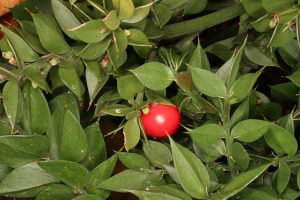Butcher’s Broom
(Ruscus aculeatus)
- Alias names for Butcher’s Broom: Family Ruscaceae (formerly Liliaceae) also known as: Kneeholy, Knee Holly, Kneeholm, Jew’s Myrtle, Sweet Broom, Pettigree. Chinese name: None found.
Pictures of Butcher’s Broom:
Flower of Butcher’s Broom nestled within the center of the leaf (cladode).
- Picture reference: https://www.hegel-system.de/de/gif/ruscus-aculeatus.jpg
About Butcher’s Broom: Butcher’s Broom a spiny, small leafed evergreen bush native to the Mediterranean and Northwest Europe that grows 38-46 inches tall. Butcher’s broom is a member of the lily family and is similar to asparagus. Small greenish flowers appear in late to early spring, and are borne singly in the centre of cladodes–a part of the leaf. The female flowers are followed by a red berry, and the seeds are bird-distributed, but the plant also spreads by rhizomes. Ruscus aculeatus occurs in woodlands and hedgerows, where it is tolerant of deep shade, and also on coastal cliffs. It is also widely planted in gardens, and has spread as a garden plant in many areas outside its native range.
Historical Actions and Uses of Butcher’s Broom:
- Atherosclerosis
- Bladder stones
- Cholesterol lowering
- Chronic venous insufficiency
- Diuretic (promotes urine flow)
- Headache
- Hemorrhoids
- Improving glucose tolerance
- Jaundice
- Menstrual bleeding
- Mild laxative
- Varicose veins (strengthens veins so they don’t leak)
Historical Uses of Butcher’s Broom and How it Works: Mature branches were once bundled and used as brooms by butchers. Young shoots were eaten as food. Early physicians used the roots as a diuretic in the treatment of urinary problems. It was also used to treat menstrual bleeding, bladder stones, jaundice, and headache. Butcher’s broom decreases vascular permeability.
Parts of Butcher’s Broom Plant Used: Roots/rhizomes and young stems as tinctures and powders.
Properties of Butcher’s Broom: Steroidal molecules called ruscogenins and neoruscogenins are responsible for the medicinal actions of butcher’s broom. Similar to diogenins, found in wild yam, ruscogenins decrease vascular permeability, which accounts for the anti-inflammatory activity of this herb and also causes small veins to constrict. Clinical studies, some double-blind, have confirmed the benefit of a combination of vitamin C, flavonoids, and butcher’s broom for treatment of venous insufficiency. Combined with flavonoids, butcher’s broom extract has been shown to benefit diabetes, by lowering cholesterol and improving glucose tolerance.
Chemical Constituents of Butcher’s Broom: Steroidal molecules called ruscogenins and neoruscogenins.
Contraindications, safety issues, concerns, harmful drug interactions and allergy precautions for Butcher’s Broom: No significant side effects noted. However, in rare cases butcher’s broom can cause nausea. *Do not take butcher’s broom if suffering from high blood pressure.
Plant Propagation Tips for Butcher’s Broom:
- Height:
36-48 in. (90-120 cm) - Spacing:
24-36 in. (60-90 cm) - Hardiness:
USDA Zone 7a to 9b (0 degrees °F to 25°F) - Seed/Plant Sources: https://davesgarden.com/guides/pf/go/2056/
Other Notes for Butcher’s Broom: Over the years I have seen many products used for cleaning the veins that contain Butcher’s broom and I carry this herb as a dry powder, but it’s rare that a client tests they need this particular herb. I don’t really know the reason why.
Helpful Links and References for Butcher’s Broom:
- Book: The Natural Pharmacy (See My Favorite Herbal Books)
- Book: Encyclopedia of Medicinal Plants (See My Favorite Herbal Books)
These products are not drugs, but foods for special dietary use pursuant to applicable Federal law. No statement in this page shall be construed as offering these products for the diagnosis, cure, mitigation, treatment, or prevention of any disease.
Related Pages:
